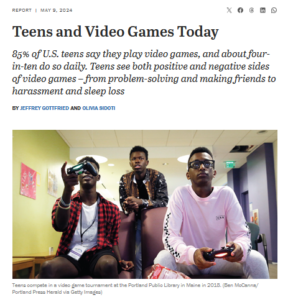Hier der Link zu einer aktuellen US-amerikanischen Studie zu Jugendlichen und Computerspielen des PEW Research Institute (https://www.pewresearch.org/internet/2024/05/09/teens-and-video-games-today/). . Zu diskutieren wäre die Frage, inwiefern diese Ergebnisse von den USA auf Deutschland übertragbar sind und wo Gemeinsamkeiten und Unterschiede bestehen.
Auf den PEW-Seiten finden sich übrigens viele einschlägige Studien für den Bereich der Medienbildung. Interessant auch jeweils die methodischen Hinweise zu den Studien („How we did this“).
——— +++ ———
„Key findings from the survey
Video games as a part of daily teen life: 85% of U.S. teens report playing video games, and 41% say they play them at least once a day. Four-in-ten identify as a gamer.
Gaming as a social experience: 72% of teens who play video games say that a reason why they play them is to spend time with others. And some have even made a friend online from playing them – 47% of teen video game players say they’ve done this.
Helpful with problem-solving, less so for sleep: Over half of teens who play video games say it has helped their problem-solving skills, but 41% also say it has hurt their sleep.
Bullying is a problem: 80% of all teens think harassment over video games is a problem for people their age. And 41% of those who play them say they’ve been called an offensive name when playing.
Boys’ and girls’ experiences differ: Most teen boys and girls play video games, but larger shares of boys identify as gamers (62% vs. 17%) and play every day (61% vs. 22%). Boys who play them are also more likely to experience positive things from it, like making friends, and more troubling things like harassment.“ (https://www.pewresearch.org/internet/2024/05/09/teens-and-video-games-today/)

